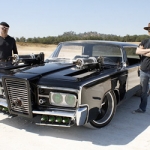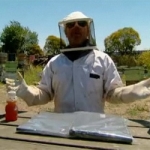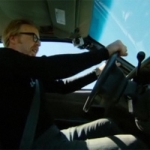
Episode: MythBusters 8.24 – “Reverse Engineering”
Original Air Date: November 17, 2010
Fasten your seat belts, MythBusters fans — it’s an episode of sports cars and car crashes. In this fast-paced episode, find out the truth about a rumored sports car design flaw — that it’s more aerodynamic going backwards than forwards — and watch as the team tackles a movie myth involving a surfboard as a lethal weapon in a highway pile-up. What will get your heart racing more: the speed, the danger, or the destruction of a really nice Porsche? Whatever you do, pay attention to the road signs — they say Slow: Spoilers Ahead.
Myth #1: A certain type of 1970s sports car (evidently a Porsche 928, although they never state the car’s make and model in the episode) was so poorly designed that it was more aerodynamic going backwards than going forwards.
MythBusters: Adam and Jamie
Procedure:
- Get a model of the car in question and put it in a tank of moving water with dye injected into the stream to show the water flow around the car.
- Put the model in a wind tunnel and determine the amount of drag on it when the wind is blowing at the front of the car, simulating the car traveling at a given speed. Repeat with the wind blowing at the back of the car.
- Get one of the cars in question. Perform a series of three driving tests to gather data about the car’s speed and power: Drive a quarter mile as fast as possible, determine the amount of time it takes for the car to go from 0 mph to 60 mph, and determine the fuel efficiency of the car when driving forwards. Repeat each test three times and take an average of the three results for each test.
- Take the body off of the car and turn it around so that the rear of the car is now the front.
- Repeat step 3 with the car in its new configuration.
- Hold a race between the flipped car and an unmodified car of the same model. The drivers will drive until the speed reaches 100 mph and maintain that speed until reaching a pre-determined point. At that point, they will shift the cars into neutral and allow them to coast to the designated finish line and see which one reaches it first.
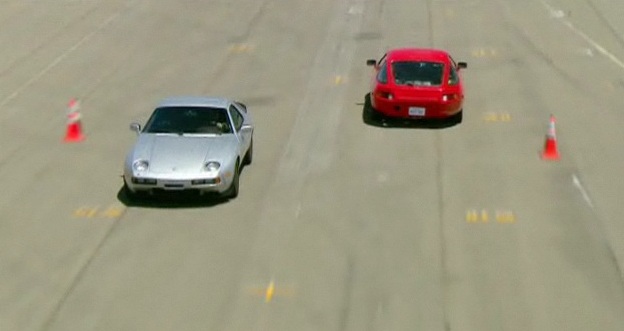
Results: The dye tests in the water tank were inconclusive — the patterns of water flow around the model car were very similar and they could not visually determine if one direction was better than the other. The wind tunnel tests produced data: forwards, the model experienced .34 pounds of drag, while backwards, it had .37 pounds of drag, suggesting that forwards is more aerodynamic. In the full-scale tests, the backwards car took an average of 2.5 seconds longer to drive the quarter mile, two-thirds of a second longer to go from 0-60 mph, and used more fuel when driving a one-mile course at a constant speed than the forwards-facing car. When the modified car competed against an unmodified one in a coasting race at a starting speed of 100 mph, the forwards-facing car crossed the finish line first.
Conclusion: Myth Busted. Actually, the results of the small-scale tests point to the fact that the car is not, in fact, more aerodynamic going backwards, but where’s the fun in stopping there? It is always much more fun to drive real cars very fast and then destroy them, if necessary, in the name of science. Or in the name of entertainment, but that’s a matter of semantics, right? The first set of full-scale tests were also deemed to be inconclusive for reasons not fully explained to the viewers, but having something to do with wildly varying numbers for the fuel efficiency test, I think. They determined the race to be the most definitive, with performance based on aerodynamics alone — when coasting, there were no engine tuning or performance issues to take into account.
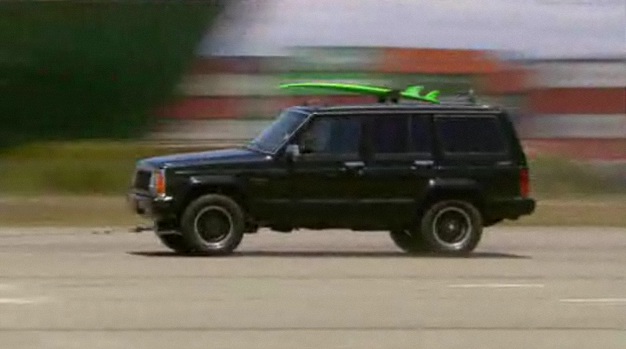
Myth #2: As depicted in the movie Lethal Weapon 2, it is possible during a crash for a surfboard to fly off of the top of a car and hit a vehicle 40 feet away with enough force to go through the windshield and kill the driver, possibly even decapitating him.
MythBusters: Kari, Grant, and Tory
Procedure:
- Set up a towing rig where the crash car, carrying the surfboard on top, will be pulled by another car so that it reaches a speed of 40 mph before crashing into a stationary car. Place the target vehicle facing the crash car 40 feet away from the place where the crash car will crash. Place Buster in the target vehicle to determine the lethality of the surfboard hit on the car.
- Construct a surfboard slingshot to launch the surfboard at 40 mph at a car windshield to determine what damage a surfboard would do to a car.
Results: The full-scale testing rig where a car was towed up to speed before crashing proved to be unreliable. The crash did not happen the same way each time, and the crash car did not come to a complete stop when hitting the stationary car. In the first test, the surfboard did not go far enough to hit the windshield of the target vehicle. In the second attempt, the board hit the stationary vehicle during the crash and was stopped from going forward. In the third attempt, the board hit the windshield but did not damage it.
When they isolated the surfboard hitting the target vehicle’s windshield part of the scenario and used a slingshot to launch the board at a car windshield at 40 mph, they found that the windshield’s safety glass absorbs the impact, preventing the surfboard from penetrating the glass and hitting the driver. Even when they launch the board at the highest speed possible with their slingshot, the safety glass continues to absorb the impact and deflect the board away from the front of the car.
Conclusion: Myth Busted, several times. First, the tests with vehicles arranged as in the movie showed that the crash vehicle would not have stopped immediately and that the surfboard could not have traveled far enough to penetrate the windshield because of its downward trajectory as soon as it leaves the top of the car. Small-scale tests of surfboard models in a dye tank subsequently demonstrate the surfboard’s lack of lift. Second, when the variables associated with crashing cars are removed and the surfboard is launched directly at a windshield at a much closer range than 40 feet, the safety glass of the windshield absorbs the impact of the surfboard and protects the driver from fatal injuries. Do visit Discovery.com, however, to see the extra footage, including what happens when automobile safety glass is replaced with plate glass.
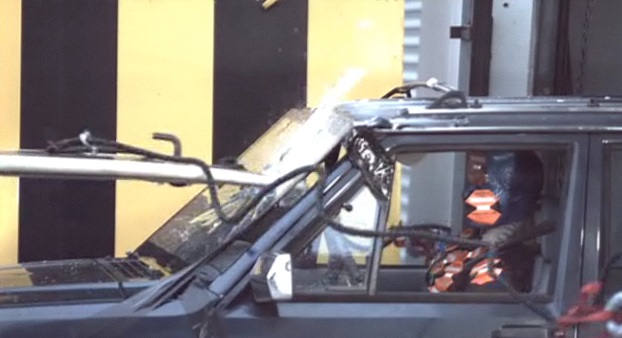
I was fairly entertained by this episode, but overall it was average at best. I am sure Adam and Jamie’s car myth was both exciting and painful to many people, but as I am not a car chick, I was neither overly impressed by their use of a sports car nor overly upset by watching them tear it to pieces and rebuild it backwards. Don’t get me wrong, it was a neat car, but I had to do a bit of Internet research to find out what kind of car was used, since they did not name it on the show — I didn’t just look at it and say, “Wow, check out that Porsche 928!” I don’t usually read message boards about MythBusters, but I came across several in my search for the car information and there seemed to be a general consensus that Adam and Jamie could have stopped with the small-scale tests and not actually ruined a perfectly good car, especially for sketchy and ill-explained “science” experiments. In the end, though, it’s all about the entertainment, and if they had stopped after testing the model in the wind tunnel, it just wouldn’t have been right. As for the ruined Porsche, add it to the list of nice cars they’ve mangled beyond repair (Long time viewers will recall a certain Corvette and dead pigs).
On the other hand, the entertainment value of continuing to bust movie myths is wearing thin. The action films whose stunts they always seem to pick are supposed to be over-the-top and unrealistic, and they have the special effects and stunt departments to prove it. The results always bear that out, too, when they take on these “myths,” and since most of the MythBusters have worked in movie special effects, I’m sure they know all this going into each episode. So, to sum up: find something more interesting than movies and keep entertaining us with myths involving speed, weapons, and especially explosions — like Jamie, I want big boom!
Rating: 3 / 5 Stars



